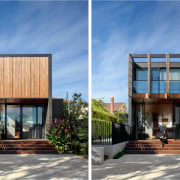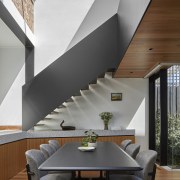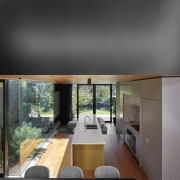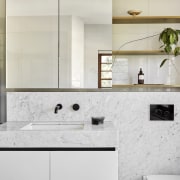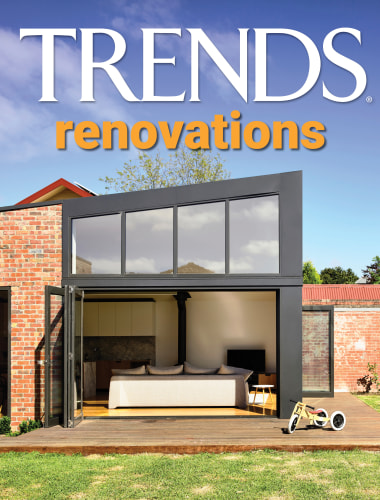Across the generations
A boldly modern addition contrasts yet respects the inter-war existing home – the extension, with operable rear facade, provides for the family's next generation
Designed by Weian Lim, Wala
From the renovating architect:
Owner brief and design response
This home is a contemporary double-storey extension to a semi-detached inter-war dwelling that caters to the growing needs of a large family.
The original period building is one of a pair of semi-detached dwellings with Art-Deco stylings reflecting its inter-war era.
The building sits on a long, narrow allotment 10m wide and 60m deep with a rearward slope falling 4.2m.
The site also backs onto a cricket ground and the Monash Freeway beyond, with northerly winds carrying the sound of traffic to the rear of the property.
The owners’ family had outgrown the original building and their brief called for an extension that could be future-proofed and cater to the changing needs of individual family members, particularly their 4 young adult children.
The design response had to expand on the functional offerings of the old house as well as ensure that any new addition respected the heritage character and scale of the period home, while being a clearly distinguishable yet connected entity.
The new addition fulfils the owners’ brief to have 2 generations of people under one roof while allowing family members to inhabit each space in their own way.
Parents’ and children’s bedrooms are housed in separate buildings connected by a central atrium.
The rear addition responds to the land’s natural fall by cascading a series of tiered living spaces towards the backyard.
Well-positioned openings bring borrowed amenity into the home to strengthen the bond between its inside spaces and out, enriching the quality of living for the family.
Heritage protection
As a building of significance, conservation of the front house was imperative.
The new addition sought to preserve the front building’s heritage qualities by utilising the fall of the land to tuck itself behind and below the existing roofline, thereby respecting the scale and proportioning of the existing building and adjacent neighbouring dwellings.
The new addition is unashamedly contemporary, a clear departure from the architecture of its predecessor in order to distinguish itself and create a counterpoint to the old building.
The result is the marriage of two “almost-separate” buildings, connected tenuously via the central atrium and its skylight wedge.
Material selection
Finishes and materials for the extension not only visually contrast that of the original dwelling, but also embody the ideals of restraint characterised by inter-War houses.
Timber, steel, concrete & bricks are employed throughout in a unified material language.
The movement between the older, austere spaces of the period building towards the more textured interiors of the renovated spaces is also delineated by this clear difference in materials.
Energy saving and sustainability principles
The design of the rear was predominantly guided by good passive design principles.
The extension and its new living space fortuitously face north to benefit from this orientation, as well as capturing northerly winds.
Large rear glazed pivot doors facilitate good cross ventilation across living spaces.
The skylight wedge over the atrium draws in more daylight and heat during winter months, heating up the thermal mass of the brick wall of the old building, and expelling heat in a slow release.
Conversely in the warmer months, the warm bricks induce a stack effect by creating points of high and low pressure within the atrium which in turn generate air flow throughout.
The feature external timber shutters on the new rear façade double as both privacy shields and acoustic buffers to insulate the house from unwanted traffic noise from the nearby highway.
Future-proofing ambition
The renovation/extension exemplifies how a well-thought design strategy can preserve and prolong the life of a 100-year-old heritage dwelling, and enable it to become a multi-generational home to adapt to the evolving lifestyles of its occupants with a new building extension that feels intuitive and robust.
The success of this project is also reflected in the seamless marriage of the old and the new – how each building has its own distinctive style and beauty, yet they come together effortlessly as a cohesive whole.
The house is respectful in its conservation of the past while being well-prepared for the future.
Home kitchen bathroom commercial design
Renovations
Renovating your home is an opportunity to refresh, expand and renew. Here's all the inspiration, ideas and information y...
Read More
